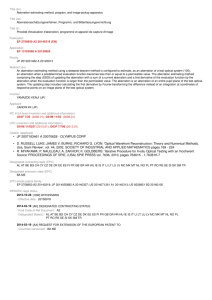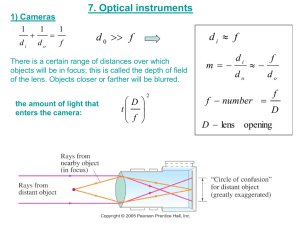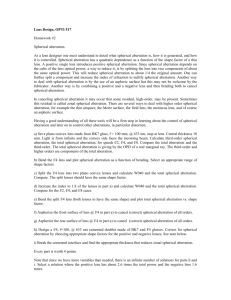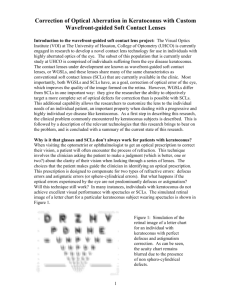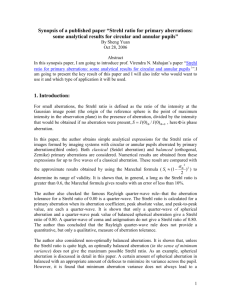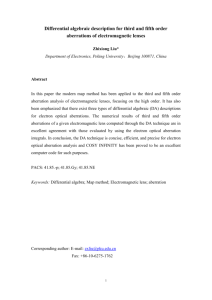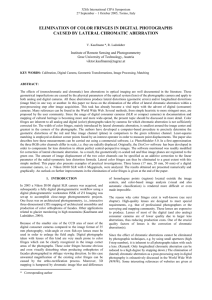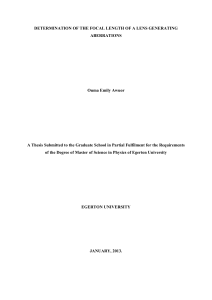CDR Presentation.ppt
advertisement
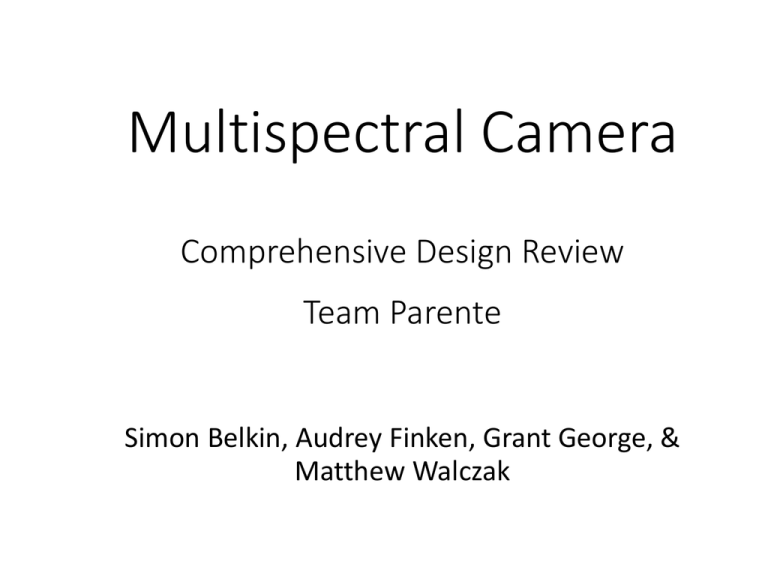
Multispectral Camera Comprehensive Design Review Team Parente Simon Belkin, Audrey Finken, Grant George, & Matthew Walczak Problem • Scientists desire the ability to capture measurements based on reflected energy (radiance) • Common camera technology only captures light in three primary wavelengths: Red, Green, and Blue (RGB) from the visible spectrum of light Solution Red = Bowline type rocks Green = Whittaker/Hillary (Jibsheet class) Blue = bright drift soil RGB = 450nm – 650nm System Design Deliverables Set at CDR Build optical system Camera can focus Capture images at different distances Aberration solution Algorithm selected Code in progress Stepper motor control Raspberry Pi control the stepper motor Can turn clockwise and counterclockwise Optical System Optical System Out of focus condition due to the addition of filter wheel required compensation. 3.75” (95.3mm) of extension tubing. A +33mm convex relay lens. Thin lens equation, 1/di = 1/f – 1/do, determines the distance to the object, do, and to the image, di. Ray Tracing Optical Distortions Aberrations due to lens occur when the light reflected off one point of an object does not converge, (or diverge), to where it is expected to go. Filter Wheel Mechanics Filter Wheel Mechanics Problem Hall Effect sensor provided in the filter wheel burned out Filter wheel doesn’t have a stable starting position Current Solution Have a static number of rotation done through the stepper motor to rotate from one filter location to the next Using Raspberry Pi Shell Script to turn the Filter wheel FDR Solution Program the filter wheel location in Python Replace Hall Effect Sensor and add to Python program to identify start location Stepper Motor Control #!/bin/sh gpio -g mode 23 out gpio -g mode 24 out echo Turn Counter Clock Wise: sleep 1 gpio -g write 24 1 for i in $(seq 400); do echo $i gpio -g write 23 1 gpio -g write 23 0 done Setting gpio pin # 24 to 1 turns Counter Clock Wise and 0 Clock Wise. Pi to Camera Interface Pi to Camera Interface Problem Mightex Camera Driver Installation “Fedora 5” to Raspbian “wheezy” supported by the Raspberry Pi Current Solution Use Windows operating system to test Camera Write existing code in python which can be ported to Pi when ready FDR Solution Mightex Camera integrated to Raspberry Pi GPIO pins if necessary Capture image command Store image Analyze data Image Processing Image Processing - Problem An optical aberration is a deviation from the optical predictions Optical aberration occurs when monochrome image captured with and without filter It occurs because the optical path and focal length is modified by putting the filter wheel between the lens and the camera Types of optical aberrations Spherical aberration Chromatic aberration Spherical Aberrations The aberration arises because the parallel light rays of incoming light do not converge at the same point after passing through the lens, resulting in a blurred image Cause - filters Lens without Spherical Aberration Chromatic Aberrations The aberration arises because the index of refraction of the lens material varies with wavelength, therefore the colors of the light passing through the lens refract by different amounts and produce a blurred image Although we are using a monochromatic camera, chromatic aberration will still occur and blur the image Solution – Image Registration Image Registration is the process of estimating an optimal transformation between two images SIFT (Scale Invariant Feature Transform) is used to generate a set of ‘interest’ points which can be used for tracking an image Use the corresponding points, to calculate a homography matrix A homography matrix is a 3×3 matrix which decides the transformation between two sets of coordinate systems RANSAC(Radom Sample Consensus) algorithm picks a minimum number of points from a given set and estimates the model. It takes points from the set which closely fit the model and calculates the error in the estimated model. This model ensures that only inliers are included and outliers are not taken into account. Image Processing - FDR Solutions Use image registration to remove blur caused by aberrations Use SIFT implementation and calculation of homography matrix in python, and apply a RANSAC algorithm to find the homography matrix and change the first image accordingly so that it matches the orientation of the second image New Team-Member Roles Simon Belkin – Hall effect sensor, integration of sensor and stepper motor code into Python Audrey Finken – Image processing & spherical aberration mitigation Grant George – Pi to camera interface, image storing & transferring Matthew Walczak – Ray tracing adjustments & chromatic aberration mitigation Final Design Review Filter wheel turning and stopping at each filter for period of time, capturing image, and rotating to the next filter Aberration mitigation for all filters Chromatic Spherical Transmitting captured image data from camera to Raspberry Pi Identifying geological markers present in rocks and soil Demo Questions Further Reading http://mars.jpl.nasa.gov/mgs/sci/fifthconf99/6071 .pdf http://naca.larc.nasa.gov/search.jsp?R=20030066 682&qs=N%3D4294950110%2B4294726774%26N o%3D10 http://ieeexplore.ieee.org/stamp/stamp.jsp?arnu mber=04664619




